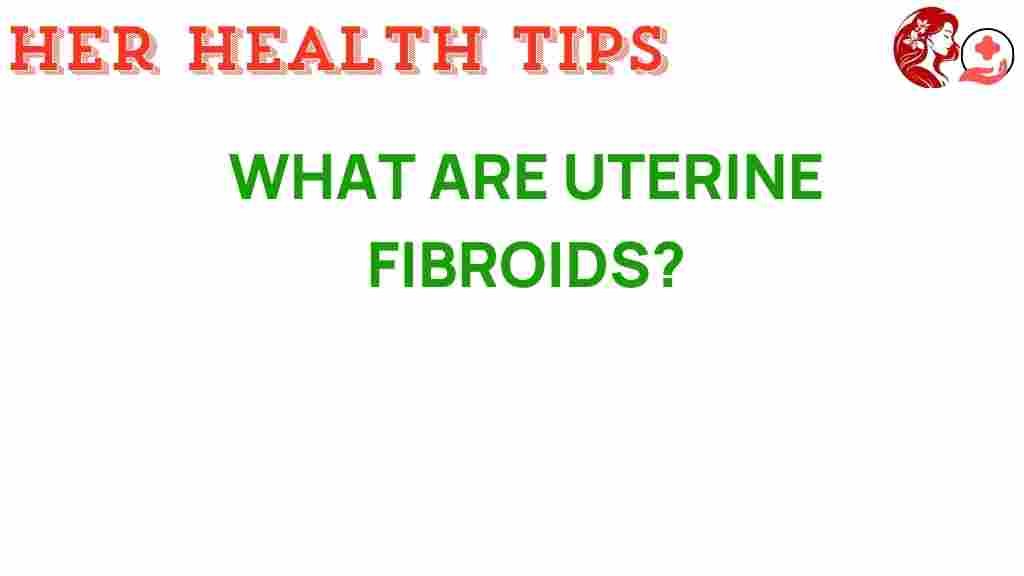Unveiling Uterine Fibroids: What Every Woman Should Know
Uterine fibroids are noncancerous growths that develop in the uterus and are a common health concern for many women. Understanding uterine fibroids is essential for women’s health, particularly for those in their reproductive years. This article aims to shed light on what uterine fibroids are, their symptoms, diagnosis, treatment options, and the importance of awareness surrounding this condition. We will also debunk some common myths associated with uterine fibroids.
What Are Uterine Fibroids?
Uterine fibroids, also known as leiomyomas or myomas, are muscular tumors that can form in the wall of the uterus. They vary in size, shape, and number, and can be as small as a pea or as large as a melon. While they can occur at any age during a woman’s reproductive years, they are most commonly diagnosed in women aged 30 to 40.
Symptoms of Uterine Fibroids
Many women with uterine fibroids may not experience any symptoms at all. However, when symptoms do occur, they can range from mild to severe and may include:
- Heavy menstrual bleeding
- Prolonged periods
- Pelvic pain or pressure
- Frequent urination
- Difficulty emptying the bladder
- Constipation
- Back pain
- Abdominal swelling
If you experience any of these symptoms, it is important to consult with a healthcare provider to discuss your reproductive health.
Diagnosis of Uterine Fibroids
Diagnosing uterine fibroids typically involves several steps:
- Medical History: Your doctor will ask about your symptoms, menstrual cycle, and family history of fibroids.
- Physical Exam: A pelvic exam may be performed to check for abnormal growths.
- Imaging Tests: Ultrasound, MRI, or CT scans can help visualize fibroids and determine their size and location.
Early diagnosis is crucial for effective treatment and management of uterine fibroids. If you suspect you may have fibroids, don’t hesitate to seek medical advice.
Treatment Options for Uterine Fibroids
The treatment for uterine fibroids depends on several factors, including the severity of symptoms, the size and location of the fibroids, and your plans for future pregnancies. Treatment options include:
- Watchful Waiting: If fibroids are small and not causing symptoms, your doctor may recommend monitoring them over time.
- Medications: Hormonal therapies can help manage symptoms, such as heavy bleeding and pain, but they do not eliminate fibroids.
- Surgical Options: If fibroids cause significant symptoms, surgical options may be considered. These include:
- Myomectomy: This procedure removes fibroids while preserving the uterus, which is suitable for women who wish to conceive in the future.
- Hysterectomy: This is the complete removal of the uterus and is a definitive solution for fibroids, typically recommended for women who no longer wish to have children.
- Minimally Invasive Procedures: Techniques such as uterine artery embolization (UAE) can shrink fibroids by cutting off their blood supply.
Discussing these options with a healthcare provider can help you determine the best approach for your situation.
Awareness and Education About Uterine Fibroids
Awareness of uterine fibroids is essential for women’s health. Many women are unaware of this common condition, leading to misconceptions and myths. Increasing awareness can empower women to seek help and understand their reproductive health better.
Common Myths About Uterine Fibroids
Several myths surround uterine fibroids that can lead to confusion and fear. Here are some common myths debunked:
- Myth 1: Uterine fibroids are cancerous.
- Myth 2: Only older women get fibroids.
- Myth 3: Fibroids always require surgery.
- Myth 4: Fibroids only cause heavy bleeding.
Understanding the facts about uterine fibroids can alleviate anxiety and encourage women to seek appropriate medical care.
Step-by-Step Process for Managing Uterine Fibroids
If you suspect you have uterine fibroids, follow this step-by-step process to manage your condition effectively:
- Recognize Symptoms: Be aware of any unusual symptoms like heavy bleeding or pelvic pain.
- Consult a Healthcare Provider: Schedule an appointment to discuss your symptoms and concerns about uterine fibroids.
- Undergo Diagnostic Tests: Follow through with the recommended imaging tests to confirm the presence of fibroids.
- Discuss Treatment Options: Work with your healthcare provider to determine the best course of action based on your individual needs.
- Follow-Up: Keep regular appointments to monitor your condition and adjust treatment as necessary.
Troubleshooting Tips for Managing Symptoms
Managing uterine fibroids can be challenging, but there are several strategies to help mitigate symptoms:
- Dietary Changes: Incorporate a balanced diet rich in fruits, vegetables, and whole grains while avoiding excess sugar and processed foods.
- Regular Exercise: Engage in regular physical activity to help manage weight and reduce stress.
- Pain Management: Use over-the-counter pain relievers as needed for pelvic pain or cramping.
- Stress Reduction: Practice relaxation techniques such as yoga or meditation to help cope with stress.
These lifestyle changes can contribute significantly to overall health and well-being.
Conclusion
Uterine fibroids are a common concern for women’s health, affecting many during their reproductive years. Understanding uterine fibroids, recognizing symptoms, and knowing the available treatment options are crucial for effectively managing this condition. Awareness and education can help demystify uterine fibroids and empower women to take charge of their reproductive health.
If you suspect you have uterine fibroids or are experiencing related symptoms, don’t hesitate to consult a healthcare provider. For more information on women’s health, you can visit Women’s Health Information. Additionally, for further reading on fibroids, check out this comprehensive guide at Fibroid Support.
By staying informed and proactive, women can navigate the challenges posed by uterine fibroids and lead healthy, fulfilling lives.
This article is in the category Reproductive and created by HerHealthTips Team
